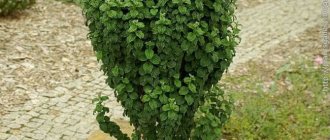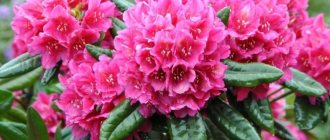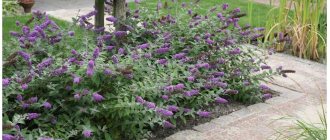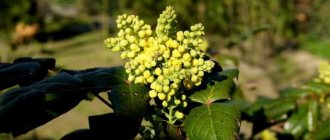To decorate a summer cottage, gardeners try to select plants that not only have an attractive appearance, but are also unpretentious in further cultivation and care. White Siberian dogwood is a fast-growing, herbaceous plant with decorative shoots.
The perennial Derain white Sibirica belongs to the Dogwood family and is regularly used in landscape design.
Peculiarities
| On a note. White dogwood - according to Wikipedia - is the same telecrania white, white svida or white Svidina - a type of plant that appeared in Siberia. Member of the Kizil genus of the Dogwood family. |
The plant's growth form is a deciduous shrub, growing from 1.5 to 2.5 m in height. It has a spreading, wide crown, the diameter of which can reach 2 meters. But landscape designers liked it not for its shape, but for the fact that at any time of the year this amazing shrub has high decorative qualities:
- bright and even variegated color of the bark - from coral-red to brown-red and even with a grayish coating;
- variegated bordered foliage that changes color in the fall (the leaves can sparkle with yellow, purple or violet);
- early and lush flowering - the shrub blooms already in the last ten days of May;
- after the white flowers, berries form on the bush;
- after planting, the white turf bush blooms in the second or third year;
- The plant can bloom twice a season.
The photo shows derain foliage in summer and autumn
Even in winter, the red shoots of white Siberian turf against the background of snow look amazing and contrasting. Therefore, the plant is often used for landscaping paths or used to create a hedge.
| On a note. White dogwood Sibirika Variegata is often planted in urban areas, thereby using it for landscaping - it has perfectly adapted to urban conditions and does not suffer from gas pollution. |
There are up to 60 species and four subgenera in the dogwood genus. White dogwood belongs to the subgenus Svidina (Svida), which is why people often call it White Svidina.
The very name of the bush - “Sibirika” - indicates its homeland - Siberia, Korea and China. It is in this part of the world that the plant is often found in the wild.
In its natural environment, the bush can grow both in the shade of other trees and in the sun. And thanks to its Siberian origin, derain has high frost resistance.
Photo of derain bush
Derain Sibirika
To decorate a summer cottage, gardeners try to select plants that not only have an attractive appearance, but are also unpretentious in further cultivation and care. White Siberian dogwood is a fast-growing, herbaceous plant with decorative shoots.
The perennial Derain white Sibirica belongs to the Dogwood family and is regularly used in landscape design.
Description of the Sibirika tree
After reading the characteristics and descriptions of White Siberian Derain, no gardener remains indifferent. Chic, bright ornamental bushes look great at any time of the year.
The leaves of the plant are quite wide, slightly pointed at the ends. The color of the Sibirika tree is rich green; closer to autumn, the bushes acquire a crimson hue.
The flowers of White Siberian Derain are small, cream-colored, and collected in lush buds. The flowering period of the plant is May-June, in the fall - September-October.
The berries are small, round in shape. The color of the fruit is white; in autumn the berries acquire a slightly blue tint.
The root of the perennial is flat, thread-like. The plant propagates well by cuttings and by dividing the bush.
The perennial can grow on almost any soil.
Deren Sibirika Variegata
White dogwood in Siberia has more than 50 species. Most varieties of perennials are used for decoration in landscape design. One of the most popular varieties is the white dogwood Sibirica Variegata. This variety is also fast-growing; it can grow up to 3 m in height.
Derain Sibirika Variegata has a wide spreading crown, the diameter of which is more than 1.5 m. This variety is significantly different from other types of perennials: the color of the bark of Derain Sibirika Variegata is brighter, often the bushes are bright red.
Bushes that are more than 10 years old may acquire a grayish tint. The leaves of the plant are ovoid, slightly folded. Flowering period is May-June.
Often the plant can bloom again in September. If the perennial is provided with proper care, the bushes will grow in one place for more than 20 years.
It is worth noting that from the description of the Sibirika Variegata derain is resistant to low temperatures, tolerates a lack of moisture and lack of sunlight.
The perennial is planted both alone and in group plantings. Such bushes look attractive in winter and have a bright, rich color.
In the photo you can see how white Siberian turf looks on the site.
White dogwood Pearl of Siberia
White dogwood Pearl of Siberia is also a fast-growing perennial. The plant has dark green leaves and burgundy stems. During the flowering period, the bushes are covered with small white flowers, which are collected in small buds.
The period of active flowering is spring and autumn. White dogwood Sibirian Pearls tolerates sudden changes in temperature well and requires minimal care.
Deren Sibirika in landscape design
White cornus alba Sibirica is regularly used for decoration in landscape design. The plant acquires its brightest colors in autumn and winter. The rich red shades of the stems leave no one indifferent. The plant can be planted in any area. Preference is given to planting in parks, gardens and dachas.
White derain looks beautiful in group planting near bodies of water. When planted alone, plants are used for landscaping and landscaping.
However, most often white Sibirika Variegata derain is used in landscape design as background bushes and protective fences near highways. The plant can withstand city conditions well and is not afraid of exhaust gases.
White Sibirika dogwood can be planted in any area, because the fiery red branches become a decoration of any garden or area on the cloudiest days.
Planting and caring for derain in Siberia
Before you start planting a plant, you need to choose the right place and prepare the soil. The perennial grows well in places that are regularly illuminated by sunlight. A small shadow for the white Siberian tree in the form of tall plants will be an additional advantage - this way the bushes look more decorative.
Planting and caring for white Sibirika Variegata dogwood is carried out in a standard manner, with strict adherence to all rules.
Landing dates
White Siberian turf is planted in early spring, rarely in autumn. To do this, you need to prepare cuttings in the summer. The shoots are taken from an adult bush and planted in moist soil.
As soon as the cuttings take root, you can begin caring for them. Regular watering and fertilizing are the basic rules for good perennial growth.
Landing rules
To properly land, you must follow these rules:
- Feed the soil before planting seedlings.
- Dig a deep hole the size of a bush root.
- Place the seedling so that the neck of the root system is at soil level.
- Fill up the planting hole.
- Water.
2 weeks after planting, it will be possible to begin the main watering and fertilizing.
Watering and fertilizing
Bushes need to be watered regularly. In dry weather, watering is carried out once a week; in rainy weather, irrigation is stopped. For proper growth after moistening, it is important to mulch the soil with straw. This way, the root system will remain moist longer.
It is also worth noting that perennials must be watered regularly. The appearance of the bush depends on the quantity and quality of watering. The most correct thing to do is to moisten the bushes at the root. Add 5-7 liters of water for each.
Fertilizing
The perennial needs regular feeding. Fertilizers are often applied in the spring. For this purpose, mineral and complex fertilizers are used. In the summer, humus or compost is added under the bushes.
Trimming
In order for the white Siberian dera bushes to have a decorative appearance, it is necessary to prune the shoots. Old and 3-year-old branches are subject to pruning. The procedure is carried out before flowering begins - in spring or late autumn.
It is also worth noting that if there are weak, leafy shoots on the bushes, they must be removed.
Preparing for winter
The Sibirika derain does not need any special preparatory measures. Only young plants need to be covered for the winter.
It is worth noting that in the autumn it is important to prune plants and apply mineral fertilizers. Closer to frost, if possible, you can cover the perennial root with fallen leaves.
Choosing a place to grow a bush
There is an opinion that white derain can grow anywhere. This is true, but in order for the bush to have high decorative qualities, you need to be more careful in choosing the place of growth.
For planting white deer, slightly acidic soils with a predominance of sandy loam or loamy soil are better suited. The bush does not tolerate clayey soils well, as well as heavy ones. If the site is just like this, then sand is added to the soil before planting the bush. And if the soil is too light, it needs to be made heavier by adding clay to it. To quickly root and develop the root system, you can add humus to the soil by mixing it with peat.
The area where it is planned to plant white turf should be well lit. But the plant will grow well even in the shade of tall trees with an openwork crown. If the area is too dark, then the bush loses its decorative color.
| On a note. White dogwood is an excellent honey crop. Its wood is often used in the manufacture of artistic products. And the berries and seeds of the crop are popularly used as medicinal products! |
Where is it used
Svidina white not only attracts attention with its all-season decorativeness and beauty (it can decorate any park or garden even in autumn and winter, without leaves), but also with its unpretentiousness, rare for a plant, which is manifested in the following:
- ability to grow in sun and shade.
- cold resistance.
- good adaptability to urban conditions.
- the ability to preserve decorativeness, even while under the crowns of taller plants.
Thanks to this, as well as its unusual appearance, Siberia is used in gardening landscape design and in landscaping cities and private farmsteads:
- alone and in groups.
- in combination with white-trunked birches, dark-trunked arborvitae or trees whose leaves turn bright colors in autumn.
- for the design of alleys and roads, house paths and the formation of hedges.
- to create background compositions.
- to disguise various outbuildings or create an interesting, memorable contrast with the white brick wall of the house.
In addition to aesthetics, telescreening also has practical significance. Its wood lends itself well to processing and serves as a good durable material for making canes and various artistic products. Derain is also known to experts in traditional medicine, who make decoctions and infusions from its berries in the fight against diseases such as:
- metabolic disorder.
- obesity.
- diabetes.
- hypertension.
- various skin pathologies.
- colds.
The seeds of this shrub are often recommended by traditional healers as one of the means to cure diseases of the liver, gastrointestinal tract, veins and joints and cleanse the body of toxins and other harmful substances. However, in case of individual intolerance and increased acidity of gastric juice, it is better not to use them.
Reproduction
White dogwood can be propagated in several ways:
- cuttings (lignified);
- by dividing a bush of mature turf;
- by seed method;
- layering.
The longest and not always successful way to propagate a plant is by seed. Its advantage is that with this method you can grow a lot of planting material (seedlings). But this is a difficult path, since a flowering ornamental bush from these seedlings is obtained only after a few years.
Cuttings
Most often, gardeners practice the vegetative method of propagating the described shrub. Cuttings are taken in early summer, cutting them from healthy adult bushes. Then the cuttings are buried in damp soil and left to take root. They are insulated for the winter and do not require any maintenance until spring. With the beginning of spring, rooted cuttings can be transplanted to the chosen growth site.
Dividing the bush
White dogwood, the planting process of which is really very simple, can be propagated even easier: by dividing the bush, layering or suckers. In the first case, the root system of the separated bush is already almost fully developed - all that remains is to plant it in a permanent place of growth.
Seeds
If the choice fell on seed propagation, then this can be done as follows: in the fall, collect ripe berries, plant them in the soil (shallow), sprinkle with a small layer of sand and cover everything with fallen leaves. The seeds will germinate in the spring. Of these, you should select the largest specimens, and pull out the small and inconspicuous ones. The remaining seedlings are left untouched for two years, after which they are transplanted to a permanent place of growth.
By layering
Derain can also be propagated by layering. To do this, bend the lower branch of the bush to the ground and dig it in, placing something heavy on top or securing it with a bracket. By next spring, a root system will form under the layering, so the plant can be separated from the mother bush and planted in its main place of growth. Something similar is done with the offspring: as soon as the offspring of the white Siberian tree gains strength, it is carefully dug up and replanted.
Diseases and pests
"Sibirika" has good immunity to infections and damage from harmful insects. At a young age, white turf can be affected by powdery mildew. Adult bushes usually do not suffer from it. A symptom of the disease is the appearance of a white coating on the foliage. The cause of infection may be drought, excess moisture, or fluctuations in daily air temperature. They treat the bush by spraying it with a decoction of horsetail. It is prepared as follows: dried herb (100 g) is poured with cold water (1 l), infused for 24 hours, then the infusion must be boiled for 40 minutes. The finished product is filtered and diluted with water (1: 5). Spraying is carried out once every 5 days.
Treatment can also be carried out with colloidal sulfur, a mixture of soda and soap. Bordeaux mixture is used when spots appear on foliage. For prevention purposes, it is recommended to plant turf with a large gap between the bushes (up to two meters), and water under the bush, since irrigating the crown can provoke disease with this fungus. White turf is extremely rarely attacked by insect pests, but the appearance of aphids, scale insects and ants is still possible. Actellik and Fosbecid are effective against scale insects; they need to be sprayed on the bush 3 times every 4 days.
Aphid colonies can be washed off with a strong water jet, or aphids can be removed by hand. In addition, insecticidal preparations can be used.
The appearance of ants is often associated with the appearance of aphids, which they feed on. Fighting aphids simultaneously prevents the appearance of these insects. In addition, installed sweet traps also get rid of ants. Preventive treatments of shrubs such as decoctions - onion and potato tops, as well as yarrow infusion - play a big role in preventing the appearance of pests.
Landing
The first condition that must be observed in order for the bush to take root and grow faster is to prepare the planting site well and choose the right planting material.
When purchasing “Sibirika” seedlings from a nursery, it is better to choose a 1–3-year-old plant: such seedlings acclimatize faster in a new place and take root. If the seedling is large, then before planting it in open ground, the roots of the bush need to be kept in water for several hours.
Planting white turf begins with digging a hole ranging from 30 cm to 0.5 meters in size - its size depends on the age of the crop and the degree of development of the roots. The root system of the bush is superficial, so there is no need to dig too deep holes.
We lay a layer of drainage on the bottom of the hole (turf does not like waterlogged soil) and sprinkle it with a nutritious soil mixture made by mixing humus and compost. After planting the bush, mulch is placed in the root circle area and watered.
Care
Having planted white turf on the site, it will be very easy to care for it, especially when it has already turned into an adult plant. Only young plantings will require more careful care.
| On a note. White Sibirika Variegata dogwood very rarely gets sick and is affected by pests, so every amateur gardener can grow it without relevant experience. |
Watering
During prolonged droughts, young bushes need to be watered at least twice a month - just pour 20-30 liters of water under the bush. The plant can grow well without special fertilizing. But in order for the plant to bloom magnificently in the spring, it can be fed with a complex of mineral fertilizers (about 150 g per plant). In the summer, the soil is flavored with organic fertilizers (up to 7 kg per bush) - this will allow the turf to develop a root system and gain strength to withstand the winter.
Trimming
For a plant such as white dogwood, care also involves pruning the branches. This is done twice a year, but only if the plant is already three years old. Moreover, after spring pruning, cuttings can be cut from the branches for propagation.
Pruning single bushes involves removing diseased, old shoots from them. In general, about a quarter of the shoots need to be removed from the bush - this will make it more compact and the crown of the plant neat.
Pruning is also done in order to get even more young, brightly colored shoots. If a white deer plant is planted as a hedge, then pruning of the shoots is done at the very beginning of summer and before the onset of autumn.
It is so easy and simple to plant and subsequently care for Siberian white turf that this plant can be seen today both near an elite cottage and on the backyard of an inexperienced gardener. This bush will make any area beautiful, original and contrasting.
The photo shows examples of the use of white wood in landscape design
Description
The shrub grows up to 3 m in height. Young shoots are bright red, erect. They turn brown with age. The crown becomes spreading, up to 3 m wide.
Source: Depositphotos
Siberian dogwood Variegata loses the decorative color of its leaves when grown in dense shade
The leaves are dark green above and light green below, with white edges or spots. In fall, the foliage turns orange-red, but the edge color or spotting remains.
The plant blooms in May-June with inflorescences up to 5 cm in diameter, consisting of small white flowers. After flowering, strawberry-like fruits appear on the bushes.
The most popular species is considered to be the Siberian derain Variegata - a shrub 1.5 m high and up to 2 m in diameter.
The dark red shoots become brighter in spring and autumn. Dark green leaves with a white edge take on a purplish-violet hue as autumn approaches. The border color is preserved.
The plant is resistant to unfavorable natural conditions, but is afraid of direct sunlight.











